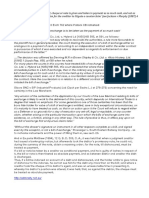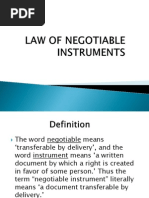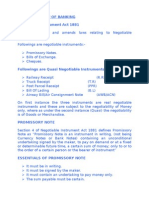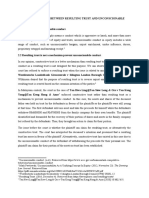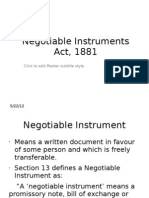Promissory Note & Bill of Exchange
Uploaded by
hemantnalekarPromissory Note & Bill of Exchange
Uploaded by
hemantnalekar.Promissory note .It contains a promise to pay .1 The liability of the maker of a note is primary and absolute (S.
3 .2 .It is presented for payment without any previous acceptance by the maker .3 The maker of a promissory note stands in immediate relationship with the payee and is .4 .primarily liable to the payee or the holder It cannot be made payable to the maker himself. The maker and the payee cannot be the .5 .same person In the case of a promissory note there are only two parties, viz., the maker (debtor) and .6 the payee .A promissory note cannot be drawn in sets .7 .A promissory note can never be conditional .8 In case of dishonor no notice of dishonor is required to be given by the Holder .9 .Bill of exchange .It contains an order to pay .1 .The liability of the drawer of a bill is secondary and conditional .2 If a bill is payable sometime after sight, it is required to be accepted either by the drawee .3 .himself or by someone else on his behalf, before it can be presented for payment The maker or drawer of an accepted bill stands in immediate relationship with the acceptor .4 .and the payee .The drawer and payee or the drawee and the payee may be the same person .5 There are three parties, viz, drawer, drawee and payee, and any two of these 3 capacities .6 .can be filled by one and the same person .The bills can be drawn in sets .7 A bill of exchange cannot be drawn conditionally, but it can be accepted conditionally with .8 .the consent of the holder .A notice of dishonor must be given in case of dishonor of Bills of Exchange .9
You might also like
- Warwick V Nairn (1855) 10 Exch 762 Where Pollock CB Remarked100% (1)Warwick V Nairn (1855) 10 Exch 762 Where Pollock CB Remarked3 pages
- Negotiable Instruments Laws Carlos Hilado Memorial State University Submitted By: Atty. Jul Davi P. SaezNo ratings yetNegotiable Instruments Laws Carlos Hilado Memorial State University Submitted By: Atty. Jul Davi P. Saez26 pages
- Bills of Exchange Cases - Sec 126 To 183No ratings yetBills of Exchange Cases - Sec 126 To 18313 pages
- 27.bill of Exchange Promissory Note and CheckNo ratings yet27.bill of Exchange Promissory Note and Check9 pages
- A Group Presentation of Business Law OnNo ratings yetA Group Presentation of Business Law On43 pages
- UNITED STATES Is A Foreign Corporation To The States of The UnionNo ratings yetUNITED STATES Is A Foreign Corporation To The States of The Union4 pages
- Bills of Exchange and Promissory Notes - UAE Legal Position PDFNo ratings yetBills of Exchange and Promissory Notes - UAE Legal Position PDF2 pages
- Unit - 2 Negotiable Instruments: Kantharaju N.P. Ananya Institute of Commerce and ManagementNo ratings yetUnit - 2 Negotiable Instruments: Kantharaju N.P. Ananya Institute of Commerce and Management9 pages
- A Negotiable Instrument Means A Promissory Note, Bill of Exchange or To Cheque Payable Either To Order or To The BearerNo ratings yetA Negotiable Instrument Means A Promissory Note, Bill of Exchange or To Cheque Payable Either To Order or To The Bearer24 pages
- Guide To Original Issue Discount (OID) Instruments: Publication 1212No ratings yetGuide To Original Issue Discount (OID) Instruments: Publication 121217 pages
- Standard Secured Promissory Note TemplateNo ratings yetStandard Secured Promissory Note Template4 pages
- Negotiable Instruments ACT, 1881: Legal Aspects of BusinessNo ratings yetNegotiable Instruments ACT, 1881: Legal Aspects of Business25 pages
- Data Warehouse/Enterprise Resource Planning in Stanley: Group Lynnet Balaji Vinoth Vignesh VasanthNo ratings yetData Warehouse/Enterprise Resource Planning in Stanley: Group Lynnet Balaji Vinoth Vignesh Vasanth16 pages
- Psychological Factors of Consumer BehaviourNo ratings yetPsychological Factors of Consumer Behaviour5 pages
- Impact of Wireless Technology On SocietyNo ratings yetImpact of Wireless Technology On Society3 pages
